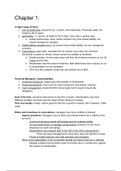Samenvatting
IBEB Finance 1 Summary & Formulasheet (Grade 10)
- Vak
- Instelling
- Boek
With this summary for the IBEB course Finance 1, you have everything you need to succeed! It includes both content from the book, as well as from lecture slides. Moreover, it also includes an EXTENSIVE formulasheet, with everything you need to do all calculations on the exams. (FEB12003X / FEB12003)
[Meer zien]




